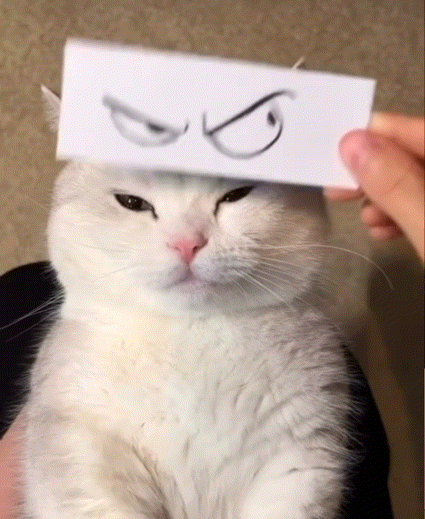Photo

Jak Wonderly
I’m honored to have been awarded First Place in the prestigious BigPicture Natural World Photography Competition (Human/Nature). I’m humbled by the other photographers that were recognized this year. Thank you to the California Academy of Sciences and the esteemed judges for recognizing my photograph.
This image is a composition of more than 200 animals that were attacked by domestic cats and brought to WildCare (San Rafael, CA) and did not survive their injuries. The bodies were collected and preserved for one calendar year.
Each year house cats kill more than 2 *billion* birds in the United States alone, in addition to mammals, reptiles, and other animals.
Thank you to WildCare: Melanie Piazza (Director of Animal Care) and Alison Hermance (Director of Communications and Marketing) were the driving force behind this project.
It was a challenge to envision something somber, dignified, truthful, and not causing revulsion. I also wanted to honor the difficult work of wildlife rescue and WildCare’s hospital staff.
Conservation starts in our own backyard with the choices we make about our pets, fences, plants, and feeders. I hope this photograph will encourage dialog about how our choices impact the animals around us.
Please visit www.discoverwildcare.org/wildlife-resources/cats-and-catios/ to learn more.
https://www.bigpicturecompetition.org/2020-winners
WildCare
[Original Post]

Here’s a comment on the original post which I found interesting as well, the rehabber states in a later comment she suspects the reason so few bats are pictured is because “many cat caught bats don’t make it to a rehab center.”
I’d also like to clarify I didn’t share this comment as a dig at OP or WildCare, I just think bats are unfortunately overlooked in this conversation and I thought seeing the input from a rehabber specializing in bats was interesting.
1K notes
·
View notes
Text

[Image Source]
Ethical Breeding: How to Find a Good Cat Breeder?
Shared from The Little Carnivore
If you are looking for a kitten of a specific breed, this article is for you. I will explain everything you need to know to find an ethical breeder and the red flags you should be careful about. You will see that there are many criteria and you can’t just pick up the first ad you see: you’ll need to do some research first. If this sounds complicated, I strongly recommend that you do not compromise on this: we are talking about the health of a kitten! If you don’t want to go through all the hassle, maybe look for a kitten at your local shelter: they will know what’s best for the kittens and you can be fairly sure they’ll do all the necessary checks.
In another article, I will explain why in my opinion ethical breeding is not the cause of cat overpopulation and shouldn’t be opposed to adopting.
The Pedigree, aka a Proof
First thing first, a kitten from a breeder should have a pedigree. A pedigree is a registration paper that certifies that your kitten belongs to a breed. It also contains the genealogy of the cat (generally 4 or 5 generations). For it to be reliable, a pedigree is generally issued by a reputable cat breed registry such as the TICA, FIFé, WCF, LOOF, CFA… depending on where you live. This means that the cattery is registered at one of those associations. This is something that you should be able to verify on their website.
The pedigree is the reflection of the work of a reputable breeder: you can verify that the breeder didn’t reproduce a mother with a son, or a brother and a sister for example.
With websites such as Pawpeds, you can also calculate the inbreeding coefficient of your cat. The lower the inbreeding coefficient, generally the better. It’s recommended to stay below 5% for 10 generations.
Without a pedigree, you have no proof that your cat belongs to a breed (No, there isn’t any DNA test for cat breeds as explained in this article). If you are looking for a cat without a pedigree, why not look at your local cat shelter? You will find many awesome cats and it will be another good way to responsibly adopt a cat.
If the breeder asks for more money to give you the pedigree or claims that you don’t need one because you won’t breed the kitten: run!
All “breeders” breeding cats without a pedigree are backyard breeders.
However, finding a breeder that sells kittens with a pedigree is not enough! Many breeders breeding cats with pedigrees are not ethical nor reputable: that’s why there are many other important criteria beyond the papers.
The Kitten’s Age
A breeder shouldn’t separate the kittens from their mother until at least when they are 12 weeks old. While kittens are weaned at around 8 weeks, they keep learning essential social skills from their mother until 14 weeks old. Being removed too early from their mother and siblings may cause many behavior issues later on, often leading to the cats being abandoned. A breeder that lets their kittens go before 12 weeks isn't a good breeder.
This is very important: if the breeder is being pushy and saying things like “the mother is rejecting the kittens” or “they already use solid food and use the litter”: run!
The Kitten’s Health
A breeder must take care of the health of their kittens. This means that the kittens need to come with a health record mentioning that they were vaccinated, treated for internal and external parasites, and microchipped.
A kitten should have received the core vaccines: feline herpes virus (FHV), feline calicivirus (FCV), feline panleukopenia (FPV), and, depending on where you live, rabies. Kittens generally receive their first vaccination at around 6-8 weeks old and get a booster at around 10-12 weeks old.
In some countries like France, it’s also mandatory that the kittens come with a health certificate from a vet. I would definitely ask the breeder if they can provide one, preferably less than 7 days old.
The parents of the kittens should be tested for infectious diseases such as the Feline Leukemia Virus (FeLV) and the Feline Immunodeficiency Virus (FIV). It’s important that for every test that I mention you request the breeder to provide you with a copy of the test result.
Testing for diseases is the most basic thing to do to breed healthy cats and if a breeder isn’t making those tests they don’t have the cats’ health in their best interest. It’s easy to lie and say that the tests were done when it’s not true, so don’t trust the breeders on their words and ask for proof.
Genetic Test
Depending on the breed, the parents of the kitten should be tested for some genetic diseases with a DNA test such as hypertrophic cardiomyopathy (HCM) for the Maine Coon and Ragdoll, pyruvate kinase deficiency (PKDef) for the Norwegian Forest Cat, Maine Coon, Siberian, Bengal…, polycystic kidney disease (PKD) for the British, Persian…, and many other diseases like the progressive retinal atrophy, spinal muscular atrophy…You can find a non-exhaustive list here.
For some breeds, the breeder should also test the blood type of the cats: unknowingly mating two cats with incompatible blood types may cause neonatal isoerythrolysis, which can result in the death of the kittens.
Health Examination
Other health tests may be needed depending on the breed such as an X-ray for hip dysplasia for Maine Coons, or an echography of the heart for hypertrophic cardiomyopathy in several breeds.
White cats should also be BAER tested to verify that they are not deaf and a breeder should never mate two white cats together as it increases the risks of deafness.
You must research the test needed for the breed you are interested in.
The Health of the Queens
It’s important that breeding female cats (called queens) don’t have more than one litter a year and that they are not bred before one year old and not after 6 to 7 years old.
This is something you can verify by yourself if the breeder keeps track of the previous litters on their website.
The Look
While, if you are looking for a pet, your kitten doesn’t have to perfectly fit the breed standard, it may be interesting to read about it and see if the breeder stays close to it.
If the breeder has cats with extreme types (hypertypes), be really careful as those cats are often prone to health issues. Additionally, breeding for extreme types is almost always done at the expense of the cat's health.
About the Breeder
It’s important that you discuss with the breeder: you should have a good feeling with them. Don’t hesitate to ask them questions: they should be happy that a future family for their kitten is interested to know more about them.
Here are some questions to evaluate the motivation of the breeder: What are their goals when breeding cats? Are they aiming to improve the breed? Are health and temperament their priority before the look?
Of course, the breeder should also be able to answer questions about the kitten: its personality, the food they eat… and to send you many pictures!
In exchange, it’s normal that the breeder also asks you many questions about your house, your interest in the breed, to verify that you will be the perfect family for their kittens. The breeder will try to evaluate if your lifestyle and character will fit with the ones of the kittens.
If the breeder doesn’t want to know anything about you, that would be a bad sign!
Depending on where you live, the breeder should have done some mandatory training or have a certificate to be allowed to breed. For example, in France, breeders must have the ACACED. Another example of a reputable course for cat breeders is the one by Pawpeds: on their website, you can find a list of all the graduates.
It’s common to visit the breeder before reserving the kitten when they are around 2 months old, after their first vaccine. This is generally great so that you can see the kitten and verify that their character will fit with your family. It’s also a good chance to verify that the kittens are growing in good conditions. Do the kittens live in the breeder's house, or in cages? Is the house clean? Do the cats and kittens look healthy? You should see the mother of the kitten and the dad (except if the stud is in another cattery: in that case, the breeder should give you some information and pictures of the dad).
If the breeder attends cat shows it’s generally a good sign, as it means they are trying to breed their cats to the standard and improve the breed. However, not showing their cat isn’t necessarily a red flag as it can be costly, not all cats enjoy it, and the breeder may be afraid to get some disease transmitted to their cat.
The breeder will establish a contract that should protect both the breeder and you. A good breeder will include a clause that the kitten cannot be resold or surrendered to a shelter. If, for any reason, you cannot keep the kitten, the breeder must be notified and they will either help to rehome the cat or take it back.
Additionally, the kitten should come neutered or spayed or the contract should include a clause that the kitten must be neutered/spayed, as this would prevent irresponsible breeding.
Lastly, a breeder should be transparent: do they list all their male and female cats? With pedigree pictures and pictures of their health test? Do they provide information on their values, on their previous litters, on their retired cats?
Be Care About These Red Flags
I’m not sure this even needs to be said, but if the kittens are growing into cages that’s definitely a big red flag.
Price
If the price is too low or too high in comparison to other catteries, that would be a red flag. I can’t give you a price range as this will vary between countries and breeds, but keep this in mind. In fact, if the price is too low, it may mean that the breeder saves money on the health tests, while if the price is very high, it could just be a scam.
International Delivery
Be especially careful if the breeder offers international shipping, especially if they don’t deliver the kitten themselves. A reputable breeder will want to meet in person the future family of their kitten.
Several Breeds
A possible red flag is if the breeder is breeding several breeds, especially more than 2 breeds. This is often (but not always) a red flag. Most breeders are passionate about one breed and focus on that breed. Breeding many breeds is often a sign of running a kitten mill.
Pet Shops
I’m not even mentioning it in this article, but you should never buy a kitten from a pet shop. The kittens almost always come from mills and grew up in poor conditions without any health care. You may think “poor kitten in the small cages”, but this is part of their strategy to get you to buy the kitten. If you buy the kitten, you are giving them the money to replace this kitten with another one and supporting the business of the kitten mills.
Extraordinary Claims
A big red flag is if a breeder tells you that their cats are particularly “rare” or “special” or “unique”, or if they make any other extraordinary claim. There is surely something fishy.
For example, if someone is selling “XXL Maine Coons”, run!
Popular Breeds
If you are looking for a kitten from a popular breed such as the Maine Coon, Bengal, or British, be especially careful when choosing a breeder. If a breed is popular it means that many people are looking for kittens from that breed: a scammer who is into it for money has all the interest to “breed” a popular breed as they will have more people to scam.
So, here were all my pieces of advice on choosing a reputable breeder, though this list is not exhaustive!
I know that when you are impatient to get a new kitten you may easily fall in love with some cute pictures. However, it’s important to take into account that you are choosing a new family member that will be with you for, hopefully, the next 15 to 20 years! But not only that: if you buy a kitten from a backyard breeder or a kitten mill you are supporting their business and giving them the means to keep breeding unhealthy cats.
To conclude I would say: adopt or shop but, more importantly, do it responsibly.
[Read Article @ Source]
1K notes
·
View notes
Text
47K notes
·
View notes
Text
There are cages and carriers full of sweet kitties all over the station, representing all four breeds of cat: Long-haired, Short-haired, Smooshy-faced, and Miscellaneous.
#wtnv#replacing all cat breeds with this#until people learn to identify them properly#I have a short haired#and a miscellaneous
111 notes
·
View notes
Text
1. Classic Tabby

[Source: Metatron Eyes Maine Coons]
2. Marbled Tabby
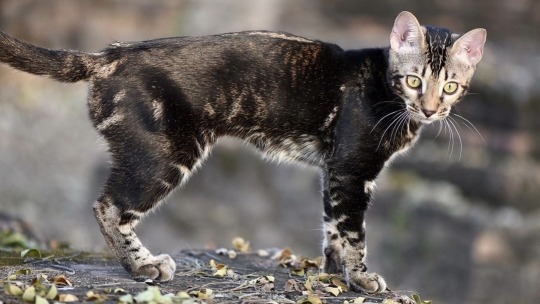
[Source: BangkokCats]
3. Mackerel Tabby

[Source: FI*RuusuLinnan Ingrid]
4. Braided Tabby

[Source: Brindle Way Toygers]
5. Spotted Tabby

[Source: NitroKatz Savannahs]
6. Rosetted Tabby

[Source: Liberty Bengals]
7. Ticked Tabby

[Source: King Size]
8. Servaline Tabby

[Source: Akilah Cat] [AAFP Position Statement: Hybrid Cats]
622 notes
·
View notes
Text
Dog shows: Hold still. No, more still. Now move your leg. No not like that. Yes the stranger is touching you ignore it. Hold still. Hold STILL ok now walk.
Cat shows: Ooooh baby cute little fuzzy baby baby look at the nice feather toy! Get it! you are such a beautiful kitty can the nice judgy give you a kissy on your widdo head?
27K notes
·
View notes
Text
happy earth day. don’t forget that someone else’s outdoor cat is your indoor cat
36K notes
·
View notes
Text

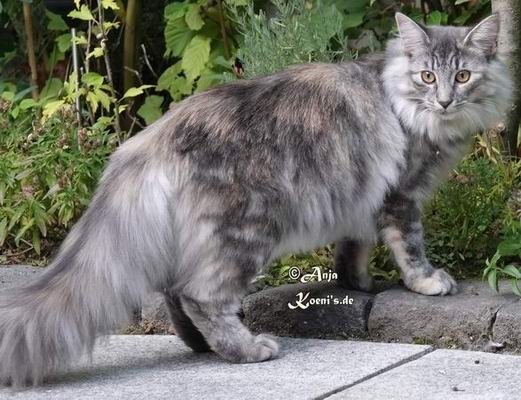


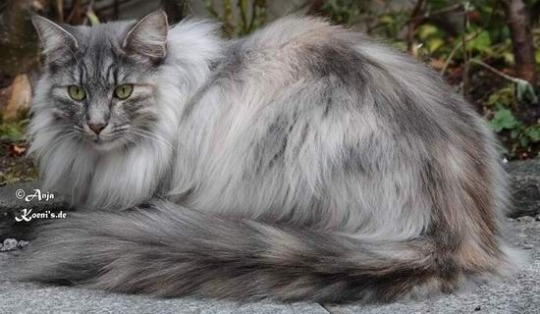
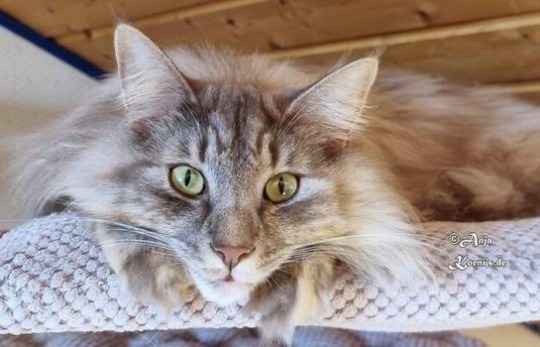
DE*Koeni’s Odessa
🐱 Norwegian Forest Cat
📸 Anja von Koenen [DE*Koeni’s]
🎨 Blue Silver Classic Tortoiseshell Tabby
176 notes
·
View notes
Note
What's the best way to tell lilac and blue cats apart at a glance?
It isn’t always easy if you don’t know what you’re looking for, I definitely had a hard time with it before I started to run this blog but I guess you pick up some things through exposure looking at and labeling thousands of cats.
If the cat is not a purebred it is generally safe to assume they’re blue not lilac. There are random-bred lilac cats out there but statistically speaking if you see a moggy and you’re not sure if they’re blue or lilac… you have a much better chance of getting it right if you assume blue.
This is also applicable to breeds where lilac is not a recognized color. In theory the cat could be produced from a breeder looking to introduce new colors into the breed… but more likely the cat is just blue.
2. If they’re side-by-side it’s usually pretty easy to tell. Blue is often referred to as gray colloquially while lilac is more… pastel, powder-y? It may also be referred to as “lavender” depending on the breed.
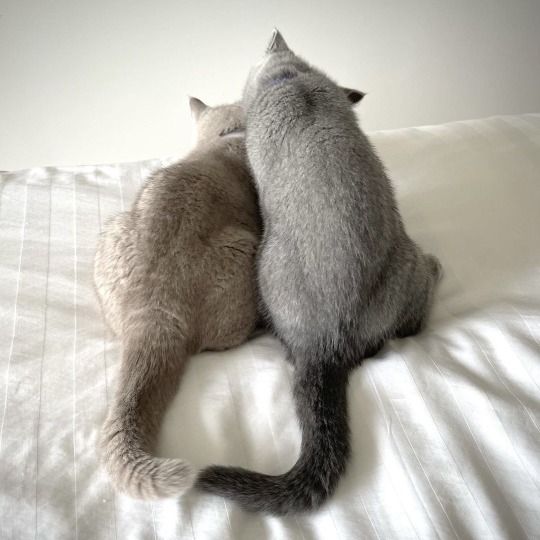

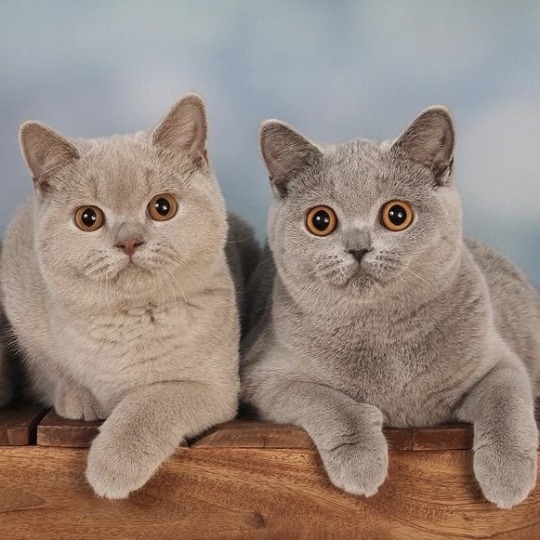
[Source][Source][Source]
Even if you don’t really know what lilac looks like you probably know what blue (or “gray”) does, so in cases where they’re side by side you can conclude the lilac cat is the not-blue cat.
3. Check the nose and paws. These are less likely to present with drastic changes due to other genes or lighting, although you have to keep in mind genetically agouti cats will have different nose leather than their no -agouti cousins of the same color. Fortunately the paw pads don’t generally seem to change.

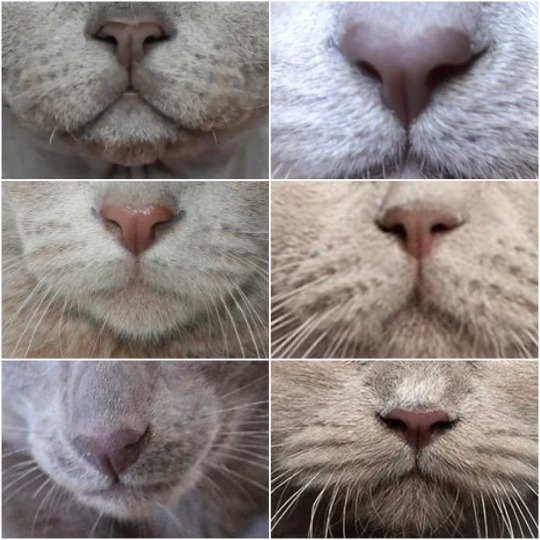
On the left we have a sampling of blue noses, depending on individual and lighting we get a range of almost-silver to slate gray to charcoal.
On the right we have a sampling of lilac noses, which often have a sort of ‘matte’ look to them and can range from a mocha-like color to sort of purple-hued but lilac pads are lighter and sort of pink-ish.


153 notes
·
View notes
Text
while kissing my cat's little head: you're a problem *smooch* you're a terror *smooch* you're a menace to society *smooch smooch smooch*
56K notes
·
View notes
Text

How Many Litter Boxes Should You Have?
Having more than one cat is wonderful. It’s comforting to know that your cats have each other for companionship when you aren’t at home. It’s heartwarming to watch your cats groom each other, play together and share a special bond.
Litter Box Overcrowding
The one aspect of living in a multicat home that isn’t as much fun is the fact that there’s more poop and pee in the litter box. This can be where many cat parents tend to drop the ball – not because they’re neglecting to keep the box clean, but simply because there isn’t enough litter box space to go around.
How Many Litter Boxes Do You Need?
So, just how many litter boxes should you have? Ideally, there should be the same number of boxes as you have cats plus one extra box for good measure. Even if you try to keep the litter box perfectly clean, some cats don’t like sharing when it comes to their elimination location. It’s more difficult to keep one box clean enough for multiple cats. When you’re gone at work all day, you don’t want one of the cats to enter a litter box and not be able to find a clean enough spot in order to urinate. An overcrowded litter box can’t possibly be kept clean enough and the result may end up being that a cat feels he has no choice but to pee somewhere else. I promise you, the place he’ll end up choosing won’t be to your liking.
Shortcuts Don’t Work
You may think you can get around the cleaning issue by investing in a self-cleaning electronic litter box but that won’t address the fact that some cats aren’t comfortable sharing the box. Cats who get along in every other aspect of their lives together may feel anxiety when they have to use a litter box another cat uses.
Location Matters
When you put additional boxes in the environment, location is key. Don’t just line several boxes up right next to each other because that essentially becomes just one giant box from a cat’s point of view. While that may be convenient for you, it can be stressful if location chosen is in an area where a particular cat doesn’t feel comfortable. In some multicat households there may be one or two cats who don’t want to cross through another cat’s area to get to the litter box.
Situate litter boxes in various parts of the house. If you know a particular cat tends to stay in a certain area, a litter box should go there. Try to create an environment where it’ll be convenient for all cats to gain access to the litter box without added anxiety.
Offer Choice
Although you can’t assign a cat to a specific litter box, the more choice you offer, the less stress there will be in the household. By placing boxes around the environment you’ll also be able to offer individual cats more litter choice as well. You may have one cat who doesn’t like the litter substrate that the other cats use so you can offer a type he prefers in the location nearest him. Problems often occur when a cat feels he has no choice and is backed in a corner. Look at your environment from the point of view of all your cats, create litter box convenience and choice. While it may be extra work to have to scoop and clean multiple litter boxes, the pay-off is huge in terms of the reduced chance of litter box aversion problems, reduced stress and an increase in feline happiness!
[Read Article & Source]
129 notes
·
View notes
Text
A neighborhood overrun with cats is a spectacle of contradictions. Our sympathy for animals has created a situation that’s terrible for animals. Cats are considered creatures of the natural world but also members of the family. (If a child had a penchant for disembowelling wildlife, would his parents shrug and say it’s just his nature?) Human progress is the argument for reforming the shelters, while long tradition is the argument for leaving cats outdoors. The people who feed feral cats are owners who don’t own them, and No Kill doesn’t mean no killing. At the root of the contradictions are difficult choices that haven’t been made. Both cats and nature pay the price.
747 notes
·
View notes
Text

Pawsabilities Call Me Maybe
🐱 Bengal
📸 Sami Kerr [A-Kerr’s Bengals]
🎨 Seal Rosetted Snow Mink
57 notes
·
View notes
Text


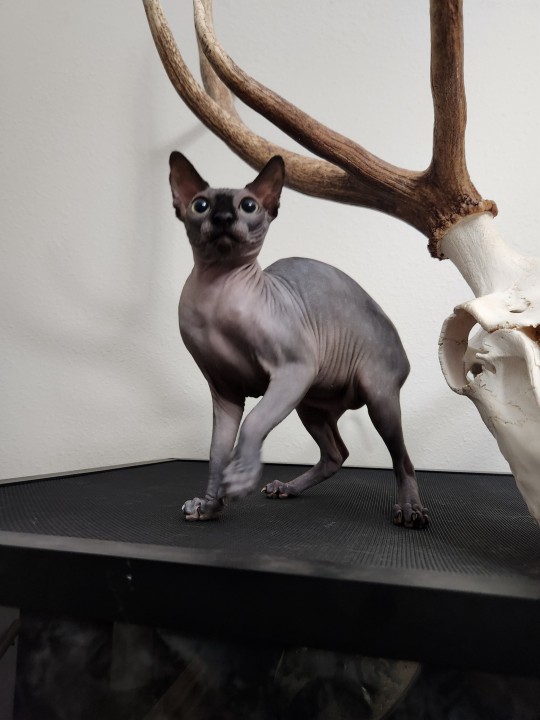
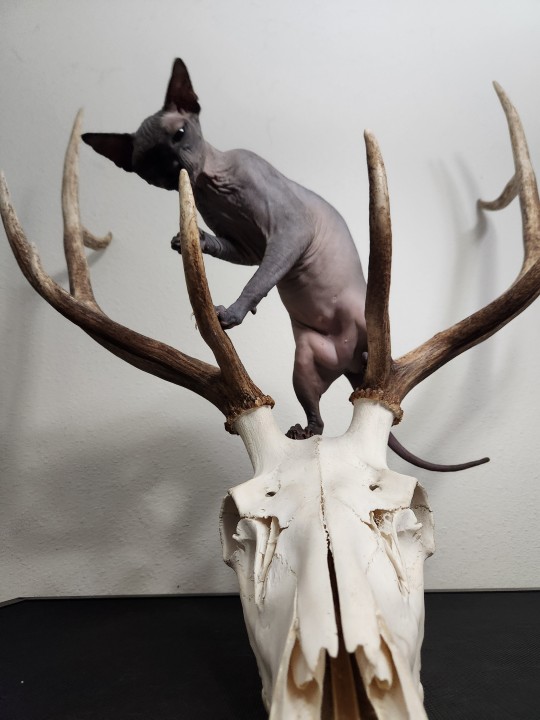
I got some pretty choice Nadja pictures the other day.
3K notes
·
View notes
